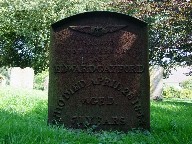| |
|
| |
|
I have visited St Nicholas
half a dozen times in the last twenty years, and
I have to tell you that I have never been able to
get into this church. Perhaps it is an unlikely
set of circumstances which has seen me arrive to
find weddings going on (twice), a funeral, the
church closed for repairs, the church locked with
no keyholder notice, and finally the keyholder
out on the occasion when there was a
keyholder notice. I wonder if the notice is still
there? Perhaps Wrentham church is wide open every
day now for all I know. But it is now five years
since my last visit, I am unlikely to be back in
that neck of the woods in the near future, and so
I thought it was about time I replaced the
original entry. If by any chance I should revisit
and, wonder of wonders, find the building
accessible, then I will gladly replace this entry
too.
For anyone travelling up the A12 from London and
Ipswich towards the Waveney ports, Wrentham comes
as a suprise - it is bigger than you'd think.
There was a concentration of 18th and 19th
Century prosperity here. You can see how it has
served travellers over the years, before the
dualling of much of the road made the journey
from London possible in two and a bit hours. A
few shops still survive, but I don't suppose many
people stop here anymore. The large
congregationalist church on the main road now
seems to be some sort of antiques warehouse, and
generally Wrentham probably benefits from the
fact that it is one of the few unbypassed
villages on the A12. Mind you, I don't live
there, so I don't have to put up with the
traffic.
As you look around, you may wonder where St
Nicholas is, for no tower peeps up above the
houses. In fact, Wrentham's parish church is
about a mile away across the fields, and although
you can reach it from a narrow lane in the
village, you will be directed off of the A12 on a
larger one if you are approaching from the south.
This takes you past a very splendid red brick
United Reformed Church.
You'll find St Nicholas sitting prettily at a
junction of narrow roads - these are obviously
ancient routes, because they curve around the
graveyard and cut down beside it, so that the
church appears to be sitting on a mound. It seems
pretty clear that this was the original heart of
the village, but that everyone drifted eastwards
when the London to Yarmouth road was put through
in the 18th century.
The graveyard is a delight; it isn't very big,
but it has a good collection of 18th and even
17th century graves, which is a most unusual
thing to find in Suffolk, or indeed, anywhere. It
surrounds what can only be described as a big
church, even for this part of Suffolk. The great
15th century tower stands tall and proud in the
middle of this island - supposedly, you can see
the sea from the top. The church beside it,
although clerestory-less, is long and wide, with
two big aisles. The northern one is Victorian,
but the other is 15th century, matching the tower
and porch. Mortlock thought that they had seen
better days, but they look pretty good to me, so
I assume they have been restored as part of the
repairs programme. The chancel is probably the
oldest part of the church, stealing 200 years on
the south aisle and tower judging by the windows,
but it is supported by red-brick flying
buttresses that are rather elegant. Mortlock
thought they might be 19th century.
So, that's as far
as I got. Inside, it is said to be
spacious, with some interesting
memorials, including a couple of brasses.
Peeping miserably through the window, all
I could see was stacks of plastic chairs,
which at least showed that there was a
bit of life in the old place.
Not far from the church, along the road
back into the village, you'll find
Suffolk's best preserved pound. This was
used in the 18th and 19th centuries to
contain stray animals rounded up in the
parish. Their owners could get them back
on payment of a fine. It is a perfectly
round, red-brick structure, a delight to
the eye. Ironic, that this parish
contains not only a building that I seem
to be finding it impossible to get into,
but another from which it is impossible
to escape. |
|
 |
|
|
|
Simon Knott, July 2015
The large photograph at the top of this page
is courtesy of Peter Stephens and retains his copyright.
|
|
|

